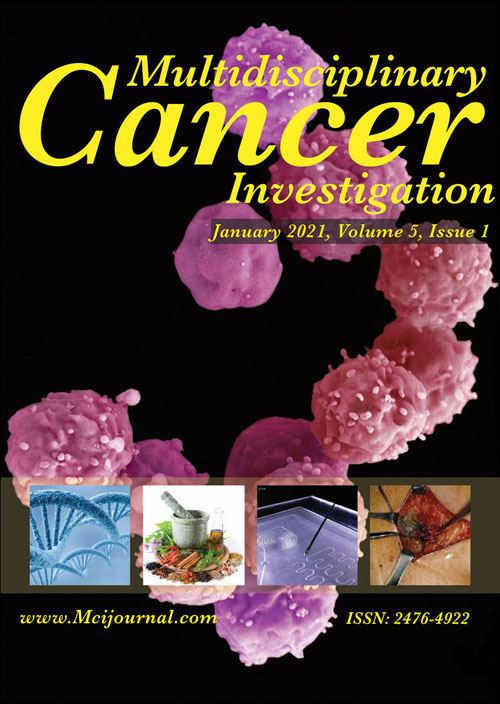فهرست مطالب

Multidisciplinary Cancer Investigation
Volume:5 Issue: 4, Oct 2021
- تاریخ انتشار: 1400/10/13
- تعداد عناوین: 6
-
-
Page 1
The present study aimed at identifying monitor unit (MU), treatment time variations, volume coverage dissimilarity, and second tumor incidence among Volumetric Modulated Arc Therapy (VMAT), Intensity Modulated Radiation Therapy (IMRT), and 3D-Conformal Radiation Therapy (3D-CRT), and treatment plans for prostate cancer based on literature review. A literature search was conducted on Pubmed/MEDLINE, BioMed Central (BMC)-part of Springer Nature, Google Scholar, and Insight Medical Publishing (iMED-Pub LTD) using the following keywords for filtering: 3D-CRT, IMRT, VMAT, Prostate Cancer, Conformity, and Homogeneity Index. IMRT was consisted of several treatment fields with different directions, hundreds of beamlets with modulated intensity, and an advantage over 3D-CRT, whereas VMAT had the advantage over IMRT due to rotating-beam utilization. VMAT usually required a longer dose optimization time and a rapid treatment, allowing patient comfort, reduced intra- fraction motion, and increased throughput compared to IMRT and 3D-CRT. VMAT has slightly better conformity and homogeneity with lower doses to normal tissue and MUs and treatment times compared to IMRT and 3D-CRT. Lower MUs reduce the risk of secondary malignancies. If target coverage and normal tissue sparing are comparable among different techniques, the risk of secondary malignancy should then be an important factor to choose the treatment modality.
Keywords: Radiotherapy, Intensity Modulated, Conformal, Prostatic Neoplasms, Clinical Protocols -
Page 2Introduction
The dose distribution in the tumor bed and the neighboring tissue is an important issue in intraoperative radiation therapy (IORT). In the current study, a new software tool was developed to calculate and visualize the 2D and 3D dose distributions of the electron beams from the light intraoperative accelerator (LIAC) and validate the software through experimental measurements.
MethodsThe Monte Carlo code ‘GATE’ was used to simulate the LIAC. Percentage depth dose curves (PDD) and transverse dose profiles (TDP) were calculated for all nominal energies in the water phantom, for the reference applicator.
ResultsThe dose distribution was defined in the form of isodose curves in the water phantom to study the volumetric and superficial changes of absorbed dose. There weren’t significant differences between calculated and measured PDD curves and TDPs. R100, R50, R90, Rp, and Ds values obtained from simulation were in good agreement with measurement. The maximum relative error was 8.6% which was related to R 100, due to the absence of charged particle equilibrium in the surface. As expected, the least error was related to R50; making it the most common parameter in electron dosimetry.
ConclusionsThe developed software is a basis to assess the dosimetric characteristics of all applicators and energy levels of the LIAC accelerator by calculating the 2D and 3D dose distribution during a proper calculation time. It can perform as a treatment planning system for IORT to calculate the absorbed dose of the clinical target volume and adjacent normal tissues which is not directly possible.
Keywords: Intraoperative, Dosimetry, Electron Beam, GATE, Radiotherapy, Monte Carlo Method -
Page 3Introduction
Maladaptive schemas influence the mental and physical health of patients. This study aimed to examine the role of early maladaptive schemas on coping styles and fear of recurrence in women with breast cancer (BC).
MethodsThis study was conducted; using a descriptive-correlational design. The research population included all female patients with BC who were referred to the radiotherapy ward of Five Hospitals in the center of Tehran from June to December 2020. The participants were 118 BC patients who were selected; using a simple random sampling technique. The inclusion criteria were undergoing radiotherapy, having BC surgery at least one month ago, and having at least a middle school education to answer questions independently. The exclusion criteria were being a widow and/or suffering from other specific physical and mental health problems in addition to cancer. The participants completed the Schema Questionnaire - Short Form (SQ-SF) (Young, 1998), the Coping Inventory for Stressful Situations (CISS; Endler & Parker, 1990), and Fear of Cancer Recurrence Inventory (FCRI). The collected data were analyzed; using the Pearson correlation coefficient and multiple linear regression analysis.
ResultsData analysis demonstrated that emotional inhibition, entitlement/grandiosity, enmeshment/undeveloped self, unrelenting standards/hyper criticalness, and insufficient self-control/self-discipline were positively correlated with fear of cancer recurrence (FCR). The strongest correlations with fear of recurrence were related to the emotional inhibition (r=0.35), unrelenting standards/hyper criticalness, and entitlement/grandiosity (r=0.28) (P<0.001). Emotional and avoidance coping styles were also associated with the fear of recurrence (r=0.50 and r=0.20). Furthermore, the independent variables could explain 41% of the variances in FCR (P<0,001).
ConclusionsUnderstanding the role of dysfunctional cognitive schemas on coping mechanisms and FCR can help clinicians and mental health professionals to form treatment interventions for BC patients.
Keywords: Recurrence, Schema Therapy, Adaptation, Psychological, Neoplasms -
Page 5Introduction
Tracheal chondrosarcoma (TCS) is a rare malignancy, with only 19 cases described in the literature to date.
Case presentationHerein, we presented the third-largest TCS with such an airway compromise that neither orotracheal intubation nor jet ventilation or even tracheostomy was possible. So, extracorporeal circulation was needed to excise the tumor in a one- stage procedure. The patient presented no tumor recurrences after surgery during an approximate7-years follow-up. So open surgical resection and end-to-end anastomosis probes may be applied as a safe and successful treatment. A review of the previous literature revealed no extracorporeal circulation in previous practices.
ConclusionManagement of tracheal chondrosarcoma is challenging due to its airway compromise during the procedure. Different treatment modalities have been advised but none of them included extracorporeal circulation as an option. We believe that this approach allows for better control of the resection and ensures better oxygenation of the patient.
Keywords: Chondrosarcoma, Trachea, Extracorporeal Circulation, Tracheal neoplasm, Surgical procedure

